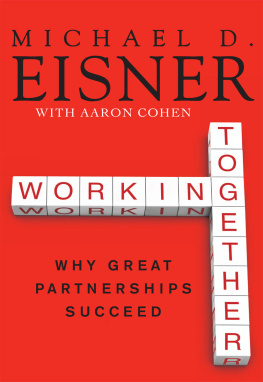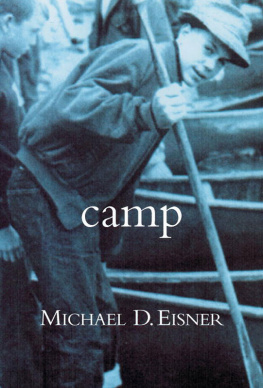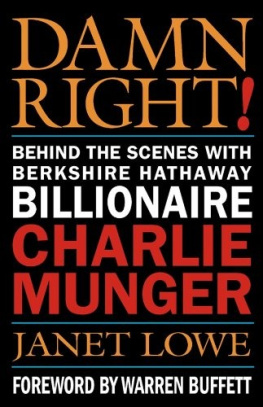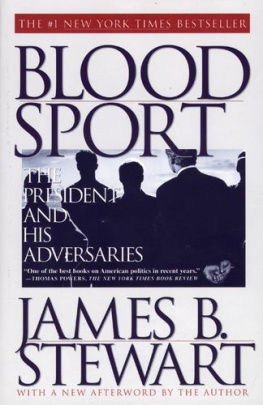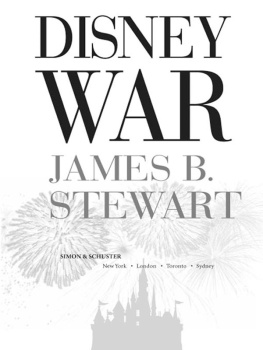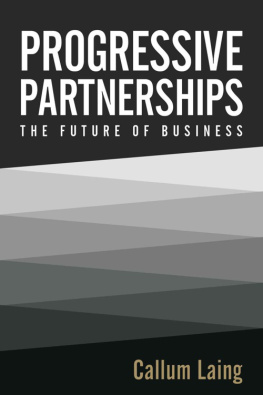Michael D. Eisner - Working Together: Why Great Partnerships Succeed
Here you can read online Michael D. Eisner - Working Together: Why Great Partnerships Succeed full text of the book (entire story) in english for free. Download pdf and epub, get meaning, cover and reviews about this ebook. year: 2010, publisher: HarperCollins, genre: Home and family. Description of the work, (preface) as well as reviews are available. Best literature library LitArk.com created for fans of good reading and offers a wide selection of genres:
Romance novel
Science fiction
Adventure
Detective
Science
History
Home and family
Prose
Art
Politics
Computer
Non-fiction
Religion
Business
Children
Humor
Choose a favorite category and find really read worthwhile books. Enjoy immersion in the world of imagination, feel the emotions of the characters or learn something new for yourself, make an fascinating discovery.
- Book:Working Together: Why Great Partnerships Succeed
- Author:
- Publisher:HarperCollins
- Genre:
- Year:2010
- Rating:4 / 5
- Favourites:Add to favourites
- Your mark:
- 80
- 1
- 2
- 3
- 4
- 5
Working Together: Why Great Partnerships Succeed: summary, description and annotation
We offer to read an annotation, description, summary or preface (depends on what the author of the book "Working Together: Why Great Partnerships Succeed" wrote himself). If you haven't found the necessary information about the book — write in the comments, we will try to find it.
Working Together: Why Great Partnerships Succeed — read online for free the complete book (whole text) full work
Below is the text of the book, divided by pages. System saving the place of the last page read, allows you to conveniently read the book "Working Together: Why Great Partnerships Succeed" online for free, without having to search again every time where you left off. Put a bookmark, and you can go to the page where you finished reading at any time.
Font size:
Interval:
Bookmark:
Work and Love and Friendship
Two of Those Three Will Result in a Great Partnership
All Three Will Result in a Great Life
To all my great partners, my loving wife of forty-three years,
my three sons and their spouses, and my present and future
grandchildren, I dedicate this book.
And to Frank Wells.
I n May of 2008, I got a phone call from Bob Miller, the founding president of Hyperion Books, the publishing unit of Disney that we began in 1991.
Im leaving Disney and starting a new imprint at Harper
Collins, he said, and you have to write a book for me.
Before I could declinemy natural first responsehe plowed forward.
How about a book about you and Frank? he said. A book about partners, and how partnerships work.
I did what I often do when I hear what I think is a great idea, even if nearly every fiber in me is saying that Im too busy and too distracted to get involved. I answered quickly.
Okay, Im in.
Soon we hung up, and it occurred to me that I had suddenly committed to a lot of effort, a lot of time, and a lot of procrastination, a Mark Twain kind of procrastination (I do not like work even when somebody else does it). Eventually I called Bob back, and asked for two years to get the book done. The idea intrigued me for a number of reasons. First, my ten years with Frank Wells at Disney were the most successful of my career. Beyond the great vision we shared for the future, no one was more engaging than Frank, and no ones drive to support ideasbusiness and creativewas more insatiable. Along with a great group of executives we assembled, from inside Disney and our alma maters Warner Bros. and Paramount, Frank and I worked hard together and succeeded together. But the comfort, camaraderie, and connection, family friendship and intellectual fellowship, all came to a crashing halt Easter Sunday in 1994, when Frank died far too young in a helicopter crash during one of his many adventurous expeditions. After that tragedy, we carried on at Disney, producing more great animated movies, building new theme parks, and climbing new mountains, including one of the largest and most significant transactions of the time, the acquisition of Capital Cities/ABC and ESPN in 1996. I remained at Disney until 2005, working with a handful of new partnerssome successfully, some very successfully, some not so muchbut none of the arrangements ever worked as seamlessly and effortlessly as the one I had with Frank Wells. And in the days, weeks, and months following my phone call with Bob Miller, I spent more and more time wondering exactly why our partnership worked so well, what had actually made that connection so extraordinarily productive and made us so much more successful than we would have been working alone.
As I thought about it, I found myself wishing I was an artist rather than a weekend writer. Inspired perhaps by Marc Chagall, I would paint three canvases to make my point, all of a man riding a horse. The first would be a tiny man atop a giant horse, the second would be a giant man atop a tiny horse, and the third would be a man and a horse of equal sizes. In the first scenario, the horse would be too strong, and too uncontrollable for the man. The second would be equally unsuccessful, for a tiny horse cant move with a giant man weighing him down. But the third match would be perfect, with the man and horse able to move successfully in concert. The man represents intellect, the horse represents emotion. Both need to be equally balanced for any leader to succeed. The best combination, Ive learned, comes from partnership, when two people balance each other, constantly reminding the other of the need to keep the conscious and unconscious in harmony, to make each other smarter, make each other better.
Since Im not a painter, I came upon a different way to answer those questions in a book. Start with a look back at my time with Frank Wells, and then go to work and find some other partnerships that succeeded. Id do some research, make a list, go talk to these partners, and hopefully learn more about how people work together. It turns out the list was easier to create than I first thought. The most successful and well-respected investor in the world, Warren Buffett, has a partner, Charlie Munger. The most successful figure to come out of the computer revolution, Bill Gates, famously worked with partners at Microsoft, and now, in his new job, saving the world (quite literally) with his foundation, he has perhaps his best partner yet: his wife, Melinda. In Hollywood, youd be hard-pressed to find a more successful or well-liked movie and television production company than Imagine Entertainmentrun by partners Brian Grazer and Ron Howard, whove won multiple Academy Awards and produced and directed dozens of movies and television series. One of the biggest retail chains in the United States, Home Depot, was started by a pair of visionaries, Bernie Marcus and Arthur Blank. In fashion, the great designer Valentino spent a half century atop his world flanked by an amazing partner, a man named Giancarlo Giammetti. In Los Angeles, among the most well-known and respected restaurant owners in town are a pair of chefs, Susan Feniger and Mary Sue Milliken, whove shown that despite the old saying, there is in fact room for two cooks in the kitchen. In finance, a company run by my childhood friend John Angelo and his partner, Michael Gordon, has been successful for decades managing billions of dollars, not only surviving the financial meltdown but growing during it. Partnership goes beyond the traditional definition of business as well. In sports, the most successful baseball manager of the last half century, Joe Torre, won his four World Series titles with a partner by his side, a man Yankee fans know well, his bench coach Don Zimmer. And even the best ongoing party of the last fifty yearsthe Studio 54 dance club in New Yorkwas run by partners Ian Schrager and the late Steve Rubell, who shared not only enormous success but, for a year, a jail cell.
Writing the book required me to spend a lot of time with these people, interviewing them about their partnerships. I started the project while buying the baseball card company Topps, making a television show, working on movie projects, advising my three sons on thirty different projects (when they let me), and being an entrepreneur. So Jane, my wife of forty-three years, suggested I politely exit the project, and stop driving myself crazy. It served as a good first lesson about partnerships: always find a partner whos not afraid to tell you what they think. She was half right on this one: I started writing, and stopped thinking about why I didnt have the time.
Once I did that, I began to realize more and more that this project was not only interesting, but important and timely. If there is a single, central story to be written about business in the twenty-first century, it is, sadly and regrettably, a story dominated by a handful of individuals who infected the economy with deceit, manipulation, and amorality; essentially the death of honesty. From destructive failures like Enron to the sociopathic deception of Bernie Madoff to irresponsible banking and real estate executives and government figures, a lack of ethics has crippled the business world over the last decade. Partnerships, however, encourage a series of characteristicstrust, teamwork, a regard for someone else, and continuing checks and balancesthat run counter to the factors that contributed to the sequence of economic messes of the last ten years. All in all, this is a perfect time to be encouraging partnerships devoid of envy, jealousy, and rivalry as a way to escape from the toxic culture that has given the business world a bad name, and to instead help people chart a new, often overlooked path toward a better way of working.
As youll see in the book, the people I met were thrilled to talk about what they shared with their partners, and what had made their pairings so successful. So much of the business world is supposed to be about getting ahead of the rest of the field, and winning while someone else loses. And there are many, many stories in business of iconic individual achievers who stood tall atop their worlds. Yet the tales of these partnerships are not just about their spectacular success. They are about something else, something far more elusive. Theyre about learning to share, and how great sharing can be: sharing success and sharing failure, adrenaline and frustration, laughter and tears. It is far from easy, though, and each of the partnerships profiled in this book illustrates different ways of sharing, and different styles of working together. It is hardly as simple as dividing up power, authority, the spotlight, salary, stock options, and success down the middle. If it was this basic, this book would not be nearly as interesting. Instead, there are many different stories to tell, stories of pairs who are similar, and tales of duos who are different; partners who were the same age and partners who were born decades apart; two men and two women or one of each; loud and colorful characters, and modest and withdrawn figures. For all the contrasts, there is one common thread. Collectively, the stories youre about to read demonstrate the virtue of something thats often forgotten about, in business and in life: these are not just all successful people, theyre also happy people. They enjoy getting up in the morning, they love what they do, and they are among the select and very fortunate few who have found that partnerships create happiness.
Font size:
Interval:
Bookmark:
Similar books «Working Together: Why Great Partnerships Succeed»
Look at similar books to Working Together: Why Great Partnerships Succeed. We have selected literature similar in name and meaning in the hope of providing readers with more options to find new, interesting, not yet read works.
Discussion, reviews of the book Working Together: Why Great Partnerships Succeed and just readers' own opinions. Leave your comments, write what you think about the work, its meaning or the main characters. Specify what exactly you liked and what you didn't like, and why you think so.

